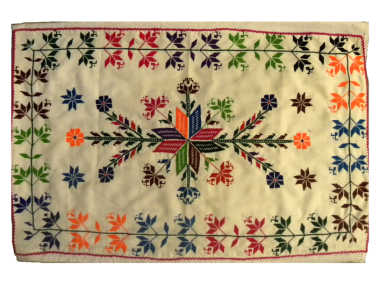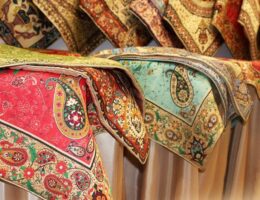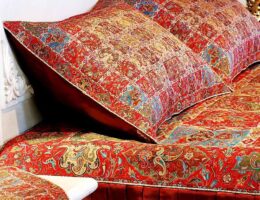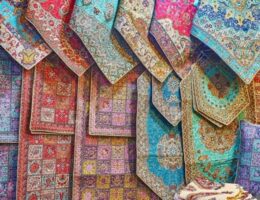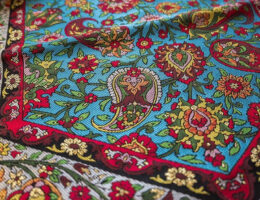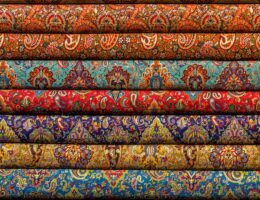IRAN ART EXHIBITION: MATERIALS USED IN PATEH DOOZI HANDICRAFTS
Pateh duzi is a type of embroidery art typical of the city of Kermān. The fabric that serves as the background to the pate is thick and wool and is called ariz (which in Farsi means wide). Those who dedicate themselves to this art are mostly girls or housewives who with the help of a needle create imaginary drawings inspired by their thoughts and personal fantasies through dots with colored threads against the background of a thick woolen fabric (ariz). Pateh duzi is one of the most beautiful and ancient traditional embroidery arts of Iran that has its deep roots in the ancient cultural history of Kermān. The fabric used possesses a delicacy and a particular beauty and is covered with delicate embroideries and only next to the sewn designs remains a very small space of the background without embroidery and sometimes even the whole background is embroidered so that it seems that it no longer exists. On average to sew a meter of pateh it takes about 4000 grams of thread. The seam of the lines drawn in the Shawl is complete and is the same as the sāghe duzi (type of floral embroidery); for the red fabrics the seam line is black, while for the white fabric the line is yellow. For the black and green fabric the lines are sewn in yellow. After the seam of the outline is finished and the main lines of the design have been embroidered, the interior is filled with a particular method of embroidery. This seam is usually present between the narrow marginal parallel lines and is filled with a different seam. The leaf color is used in white, black, crimson, green and light blue pateh. In pateh red, white, yellow, light blue and green. In the green pateh white, light blue, yellow, black and crimson. In dark blue pateh white, yellow, light blue and green. After seaming, the pateh is left in cold water where detergent has been put in for a short time, then it is rubbed a little and is washed several times until the water is completely clear; after it has released all the water, it is left to dry and is ironed. Usually with the embroidered pateh objects are prepared such as: the cover of the Koran – the prayer mat – types of decorative paintings – tablecloths (small and for the dining table and the coffee table) – bedspread-backrest-cushions-curtains- coasters-placemats-napkin holders and so on.
Weaving of various types of traditional fabrics
Traditional hand-woven fabrics: everything that is woven with the hands or with the help of simple tools is called “dast-bāft” (literally: knotted, hand-woven). There are fabrics that become clothes, rugs, other objects and sometimes decorative elements. In general, hand-woven fabrics are of two types: those woven by machine and those woven with the loom. Machine-made or traditional fabrics are objects produced with the help of textile machines and the like, such as plain and patterned fabrics, brocade, termeh, velvet, rugs, etc. What is left of traditional Iranian weaving it consists of brocade and velvet processing machines found in the traditional arts workshops of the Cultural Heritage Authority in the cities of Tehrān, Kāshān, Esfahān and Yazd. In addition to those, also in the areas of Yazd, Kāshān, Kermān, Khuzestān, Gilān, Mazandarān, Azerbāijān, Kurdistān and Kermānshāh fabrics are woven in the traditional way. Some types of these fabrics are: she’er (fabric with animal hair or silk is woven with the chāhārvardi machine), hemp, brocade, termeh, velvet and fabrics used for rugs. The other traditional fabrics can be listed below: thick and woolen fabrics such as tunic which is made from camel fluff or sheep’s wool and its place of production is the village of Mohammadieh in the city of Nāiin. Linen or cotton fabrics used as bedspreads, bedspreads, floor covers or bedspreads which usually have a checkered and striped pattern and whose production location is in the cities of Esfahān, Yazd, Ardakān and Shushtar. The famous shawl called Hossein Gholi Khān in Yazd, ghanāviz in Yazd and Kāshān, suf in Bushehr, Jājimce or hammām sari in Ziārat village in Gorgān and Ālādasht in Mazandarān, ghatn which is a type of summer cloth in Yazdā iākdā , chādor shab (bed cover) in Sirjān and also the silk chādor shab from Ghāssem Ābād of Rudsar, are other traditional hand-woven fabrics of Iran.
Fabrics with the loom: they are hand-woven with the help of horizontal and vertical looms.
IRAN ART EXHIBITION: These products are of two types: woolly fabrics with the loom like some types of carpets: in the cities of Esfahān, Qom, Sāveh, Marāgheh, Banāb and Zanjān, Tabriz, Nāiin, Kermān, Kāshān, Bijār and Arāk, Chahārmahāl and Bakhtiāri, Mashhad , Sabzevār, Sistān and Baluchistān, Gonbad, Shirāz, Sanandaj and among the nomads of Iran and woven with hairless looms such as the kilims, the reversible ones (simple) and the monoverse ones (Sumākh: varani and shiriki pich).
The weaving of the Barak
Barak is a type of soft, adherent and thick fabric that is woven by hand and is made from camel wool or goat fluff and with which winter clothes are sewn. The most requested barak is provided by goat fluff and a cheaper type from camel wool. It has a delicacy and at the same time a particular strength and is usually used to prepare and sew men’s jackets. The warmth of the very thick and soft fabrics of the barak, soothes muscle aches and is also healing for joint pains. It normally has its own color and is produced in brown, black, white, milk, cream and gray colors. In the past it was mostly the dervishes who made tunics and hats with barak and later, with the improvement of its quality, even kings and rulers wore tunics and caftans of barak.
Today barak in Iran is rare. Bajestān, Gonābād, Ferdous and Bashruyeh in the Khorāsān are the main production villages of this cloth which is also woven in the region of Kermān. Famous varieties of it were in the past in the tribes of Hazāreh (Barak of Hazāreh) in Bashruyeh (region Khorāsān ) and currently Mashhad is the barak sales center. Until a few decades ago, this wool industry made up a large part of the men’s clothing in the areas mentioned and many people created shawls, blankets, jackets, vests, hats, etc.
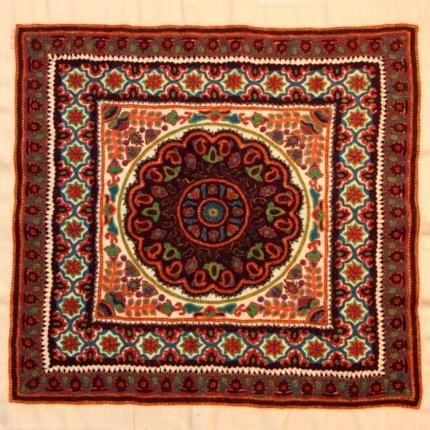
The paintings of the coffee house
The paintings of the coffee house are a type of Iranian oil painting. Storytellers play an important role in describing these artistic skills; they usually narrate martial, religious and convivial stories related to paintings. This type of painting reached its peak at the end of the Qajar era, coinciding with the period in which the constitutional revolution in Iran was about to assert itself. The beginning of this art refers to the reading of stories, to the commemoration in elegiac verses and to the recitation of tazieh in Iran which has a long tradition prior to the spread of coffee and tea houses. This type of painting was a new phenomenon in the artistic history of Iran; it is a combination of religious and patriotic values representing the mythos of the epics, the altruism of religious leaders, the twelve Imams as well as national heroic athletes. Many of these paintings represent the Āshurā and the stories of the Shāhnāmeh.
When the constitutional revolution established itself, a great awareness spread in the thoughts of the people and the number of people in search of freedom increased considerably. Once this popular art was put back into use, the epic, religious stories and national wars for freedom became a means of making people aware by pushing them to fight. At that time the painters of coffee houses made such remarkable paintings that this art later became popular in society. Even the panegirists as well as the narrators read stories with the help of these paintings in the hussanyehs, in the tekyehs and in the coffee houses which played a huge role in keeping these events alive.
IRAN ART EXHIBITION: Hossein Qollar-Aqasi was a famous painter of coffee houses who excelled in epic paintings. Muhammad Modabber is also a great personality in the field of religious paintings. Notable works by these artists are kept in the Reza Abbasi Museum.
Pateh needlework
Pateh needlework The other names of pateh needle work is Selsele needlwork or fateh needlework. The oldest piece of pateh, which is now available, is related to Farajollah Kermani, and then, the cover of the tomb of Shah Nematollah in Mahan, which dates back to 1285 AH. Pateh is a needlework that usually covers most of the fabric parts by the seams of Alwan.
Needlework
Needlework, creating a role, is made up of fabric-colored stitches with a very simple and primitive tool. This tool consists of a thimble and needle sewing and colored stitches. The skilled craftsman traverses the color among the fabric , drawing a drawing patterns from his mind and soul.
